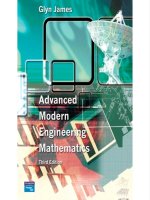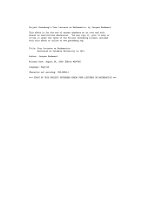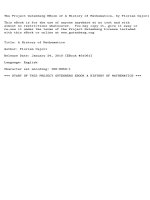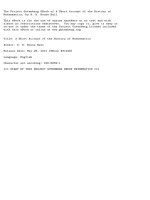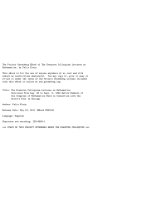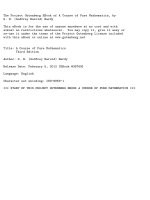Applied engineering mathematics by brian vick
Bạn đang xem bản rút gọn của tài liệu. Xem và tải ngay bản đầy đủ của tài liệu tại đây (19.38 MB, 247 trang )
Applied Engineering
Mathematics
www.pdfgrip.com
www.pdfgrip.com
Applied Engineering
Mathematics
Brian Vick
www.pdfgrip.com
Visit the eResources: www.crcpress.com/9780367432768
MATLAB ® is a trademark of The MathWorks, Inc. and is used with permission. The MathWorks does
not warrant the accuracy of the text or exercises in this book. This book’s use or discussion of MATLAB ®
software or related products does not constitute endorsement or sponsorship by The MathWorks of a
particular pedagogical approach or particular use of the MATLAB ® software.
CRC Press
Taylor & Francis Group
6000 Broken Sound Parkway NW, Suite 300
Boca Raton, FL 33487-2742
© 2020 by Taylor & Francis Group, LLC
CRC Press is an imprint of Taylor & Francis Group, an Informa business
No claim to original U.S. Government works
Printed on acid-free paper
International Standard Book Number-13: 978-0-3674-3277-5 (Hardback)
This book contains information obtained from authentic and highly regarded sources. Reasonable efforts have been
made to publish reliable data and information, but the author and publisher cannot assume responsibility for the validity of all materials or the consequences of their use. The authors and publishers have attempted to trace the copyright
holders of all material reproduced in this publication and apologize to copyright holders if permission to publish in this
form has not been obtained. If any copyright material has not been acknowledged please write and let us know so we
may rectify in any future reprint.
Except as permitted under U.S. Copyright Law, no part of this book may be reprinted, reproduced, transmitted, or
utilized in any form by any electronic, mechanical, or other means, now known or hereafter invented, including photocopying, microflming, and recording, or in any information storage or retrieval system, without written permission
from the publishers.
For permission to photocopy or use material electronically from this work, please access www.copyright.com (http://
www.copyright.com/) or contact the Copyright Clearance Center, Inc. (CCC), 222 Rosewood Drive, Danvers, MA
01923, 978-750-8400. CCC is a not-for-proft organization that provides licenses and registration for a variety of
users. For organizations that have been granted a photocopy license by the CCC, a separate system of payment has been
arranged.
Trademark Notice: Product or corporate names may be trademarks or registered trademarks, and are used only for
identifcation and explanation without intent to infringe.
Visit the Taylor & Francis Web site at
and the CRC Press Web site at
www.pdfgrip.com
Contents
xi
xiii
Preface
About the Author
1 Overview
1.1
1.2
1.3
1.4
1.5
1.6
1
Objectives 1
Educational Philosophy 2
Physical Processes 3
Mathematical Models 3
1.4.1 Algebraic Equations 4
1.4.2 Ordinary Differential Equations 4
1.4.3 Partial Differential Equations 4
Solution Methods 5
Software 7
2 Physical Processes
2.1
2.2
2.3
2.4
2.5
9
Physical Phenomena 9
Fundamental Principles 10
Conservation Laws 11
2.3.1 Conservation of Mass: Continuity 11
2.3.2 Conservation of Momentum: Newton’s Second Law 12
2.3.3 Conservation of Energy: First Law of Thermodynamics 13
Rate Equations 14
2.4.1 Heat Conduction: Fourier’s Law 14
2.4.2 Heat Convection: Newton’s Law of Cooling 15
2.4.3 Thermal Radiation 15
2.4.4 Viscous Fluid Shear: Newton’s Viscosity Law 16
2.4.5 Binary Mass Diffusion: Fick’s Law 17
2.4.6 Electrical Conduction: Ohm’s Law 17
2.4.7 Stress-Strain: Hooke’s Law 17
Diffusion Analogies 17
3 Modeling of Physical Processes
3.1
19
Cause and Effect 19
3.1.1 General Physical Process 19
v
www.pdfgrip.com
vi
Contents
3.1.2 Thermal Processes 20
3.1.3 Mechanical Processes 20
3.2 Mathematical Modeling 20
3.3 Complete Mathematical Model 22
3.3.1 Mechanical Vibrations 23
3.3.2 Heat Conduction 24
3.4 Dimensionless Formulation 26
3.4.1 General Procedure 26
3.4.2 Mechanical Vibrations 27
3.4.3 Steady Heat Conduction 29
3.5 Inverse and Parameter Estimation Problems 31
3.5.1 Direct Problem 31
3.5.2 Inverse Problem 31
3.5.3 Parameter Estimation Problem 31
3.6 Mathematical Classifcation of Physical Problems 32
Problems 32
4 Calculus
4.1
4.2
4.3
4.4
4.5
4.6
37
Derivatives 38
4.1.1 Basic Concept of a Derivative 38
4.1.2 Velocity from Displacement 38
4.1.3 Derivative of tn 39
4.1.4 Chain Rule 40
4.1.5 Product Rule 40
4.1.6 Partial Derivatives 41
Numerical Differentiation: Taylor Series 42
4.2.1 Taylor Series Expansion 42
4.2.2 First Derivatives Using Taylor Series 43
4.2.3 Second Derivatives Using Taylor Series 44
Integrals 45
4.3.1 Basic Concept of an Integral 45
4.3.2 Geometric Interpretation of an Integral: Area Under a Curve 46
4.3.3 Mean Value Theorem 47
4.3.4 Integration by Parts 48
4.3.5 Leibniz Rule: Derivatives of Integrals 48
Summary of Derivatives and Integrals 50
The Step, Pulse, and Delta Functions 52
4.5.1 The Step Function 52
4.5.2 The Unit Pulse Function 52
4.5.3 The Delta Function 54
Numerical Integration 55
4.6.1 Trapezoid Rule 56
4.6.2 Trapezoid Rule for Unequal Segments 58
4.6.3 Simpson’s Rule 60
4.6.4 Simpson’s 3/8 Rule 61
4.6.5 Gauss Quadrature 62
www.pdfgrip.com
Contents
vii
4.7 Multiple Integrals 64
Problems 65
5 Linear Algebra
77
5.1
5.2
5.3
Introduction 78
Cause and Effect 78
Applications 79
5.3.1 Networks 79
5.3.2 Finite Difference Equations 80
5.4 Geometric Interpretations 81
5.4.1 Row Interpretation 81
5.4.2 Column Interpretation 81
5.5 Possibility of Solutions 82
5.6 Characteristics of Square Matrices 82
5.7 Square, Overdetermined, and Underdetermined Systems 85
5.7.1 Overdetermined Systems 85
5.7.2 Underdetermined Systems 85
5.7.3 Square Systems 85
5.8 Row Operations 86
5.9 The Determinant and Cramer’s Rule 87
5.10 Gaussian Elimination 87
5.10.1 Naïve Gaussian Elimination 87
5.10.2 Pivoting 88
5.10.3 Tridiagonal Systems 89
5.11 LU Factorization 89
5.12 Gauss–Seidel Iteration 90
5.13 Matrix Inversion 90
5.14 Least Squares Regression 91
Problems 93
6 Nonlinear Algebra: Root Finding
6.1
6.2
Introduction 99
Applications 100
6.2.1 Simple Interest 100
6.2.2 Thermodynamic Equations of State 101
6.2.3 Heat Transfer: Thermal Radiation 101
6.2.4 Design of an Electric Circuit 102
6.3 Root Finding Methods 104
6.4 Graphical Method 104
6.5 Bisection Method 105
6.6 False Position Method 105
6.7 Newton–Raphson Method 107
6.8 Secant Method 108
6.9 Roots of Simultaneous Nonlinear Equations 109
Problems 112
www.pdfgrip.com
99
viii
Contents
7 Introduction to Ordinary Differential Equations
119
7.1
Classifcation of Ordinary Differential Equations 119
7.1.1 Autonomous versus Nonautonomous Systems 120
7.1.2 Initial Value and Boundary Value Problems 120
7.2 First-Order Ordinary Differential Equations 121
7.2.1 First-Order Phase Portraits 121
7.2.2 Nonautonomous Systems 123
7.2.3 First-Order Linear Equations 123
7.2.4 Lumped Thermal Models 124
7.2.5 RC Electrical Circuit 125
7.2.6 First-Order Nonlinear Equations 126
7.2.7 Population Dynamics 126
7.3 Second-Order Initial Value Problems 128
7.3.1 Second-Order Phase Portraits 128
7.3.2 Second-Order Linear Equations 129
7.3.3 Mechanical Vibrations 130
7.3.4 Mechanical and Electrical Circuits 130
7.3.5 Second-Order Nonlinear Equations 131
7.3.6 The Pendulum 131
7.3.7 Predator–Prey Models 132
7.4 Second-Order Boundary Value Problems 133
7.5 Higher-Order Systems 133
Problems 134
8 Laplace Transforms
139
8.1
8.2
8.3
8.4
Defnition of the Laplace Transform 139
Laplace Transform Pairs 140
Properties of the Laplace Transform 140
The Inverse Laplace Transformation 141
8.4.1 Partial-Fraction Expansion Method 141
8.4.2 Partial-Fraction Expansion for Distinct Poles 142
8.4.3 Partial-Fraction Expansion for Multiple Poles 143
8.5 Solutions of Linear Ordinary Differential Equation 143
8.5.1 General Strategy 143
8.5.2 First-Order Ordinary Differential Equations 144
8.5.3 Second-Order Ordinary Differential Equations 146
8.6 The Transfer Function 146
8.6.1 The Impulse Response 147
8.6.2 First-Order Ordinary Differential Equations 148
Problems 149
9 Numerical Solutions of Ordinary Differential Equations
9.1
9.2
Introduction to Numerical Solutions 152
Runge–Kutta Methods 153
9.2.1 Euler’s Method 153
9.2.2 Heun’s Method 153
www.pdfgrip.com
151
Contents
ix
9.2.3 Higher-Order Runge–Kutta Methods 155
9.2.4 Numerical Comparison of Runge–Kutta Schemes 155
9.3 Coupled Systems of First-Order Differential Equations 156
9.4 Second-Order Initial Value Problems 157
9.5 Implicit Schemes 158
9.6 Second-Order Boundary Value Problems: The Shooting Method 160
Problems 161
10 First-Order Ordinary Differential Equations
169
10.1 Stability of the Fixed Points 169
10.1.1 RC Electrical Circuit 171
10.1.2 Population Model 171
10.2 Characteristics of Linear Systems 171
10.3 Solution Using Integrating Factors 172
10.4 First-Order Nonlinear Systems and Bifurcations 174
10.4.1 Saddle-Node Bifurcation 175
10.4.2 Transcritical Bifurcation 176
10.4.3 Example of a Transcritical Bifurcation: Laser Threshold 177
10.4.4 Supercritical Pitchfork Bifurcation 179
10.4.5 Subcritical Pitchfork Bifurcation 179
Problems 182
11 Second-Order Ordinary Differential Equations
193
11.1
11.2
11.3
11.4
11.5
Linear Systems 193
Classifcation of Linear Systems 196
Classical Spring-Mass-Damper 196
Stability Analysis of the Fixed Points 200
Pendulum 202
11.5.1 Fixed Points: No Forcing, No Damping 204
11.5.2 Fixed Points: General Case 204
11.6 Competition Models 205
11.6.1 Coexistence 206
11.6.2 Extinction 208
11.7 Limit Cycles 208
11.7.1 van der Pol Oscillator 211
11.7.2 Poincare–Bendixson Theorem 211
11.8 Bifurcations 212
11.8.1 Saddle-Node Bifurcation 212
11.8.2 Transcritical Bifurcation 213
11.8.3 Supercritical Pitchfork Bifurcation 214
11.8.4 Subcritical Pitchfork Bifurcation 214
11.8.5 Hopf Bifurcations 214
11.8.6 Supercritical Hopf Bifurcation 215
11.8.7 Subcritical Hopf Bifurcation 217
11.9 Coupled Oscillators 217
Problems 219
229
Index
www.pdfgrip.com
www.pdfgrip.com
Preface
This book is a practical approach to engineering mathematics with an emphasis on visualization and applications. This book is intended for undergraduate and introductory
graduate courses in engineering mathematics and numerical analysis. It is aimed at students in all branches of engineering and science. This book contains a comprehensive
blend of fundamental physics, applied science, mathematical analysis, numerical computation, and critical thinking. It contains both theory and application, with the applications interwoven with the theory throughout the text. The emphasis is visual rather than
procedural.
This book covers some of the most important mathematical methods and tools used in
applied engineering. After an introduction in Chapter 1, this book begins with a summary
of the most important principles of physics in Chapter 2, followed by Chapter 3 dedicated
to the proper mathematical modeling of physical processes. Then the basics of calculus are
presented in Chapter 4, including a thorough treatment of numerical integration. Next the
essentials of linear algebra are presented in Chapter 5. Then the topic of nonlinear algebra,
with an emphasis on numerical methods, is presented in Chapter 6. The topic of the remaining fve chapters is ordinary differential equations. An introduction is presented in Chapter 7,
giving an overview and fundamental understanding of the origins and meaning of differential equations. Then the Laplace transform method is presented in Chapter 8. A thorough
treatment of the numerical solution of ordinary differential equations is then described in
Chapter 9. Chapters 10 and 11 are on frst-order and second-order ordinary differential
equations, respectively, and cover some important examples and characteristics of frst- and
second-order equations, including bifurcations. Although the chapters stand alone and can
be studied in any order, the organization of this book is a logical sequence from mathematical modeling to solution methodology.
A distinctive characteristic of the text is that the visual approach is emphasized as opposed
to excessive proofs and derivations. The reader will take away insight and deeper understanding with the visual images and thus have a better chance of remembering and using
the mathematical methods. Many of the fgures were created and computations performed
with Mathematica, and the dynamic and interactive codes accompanying the examples are
available for the reader to explore on their own.
My style has been developed from experience as a long-time teacher and researcher in a
variety of engineering and mathematical courses. My background includes the areas of heat
transfer, thermodynamics, engineering design, computer programming, numerical analysis,
and system dynamics at both undergraduate and graduate levels. Also, my experiences in
various research areas have motivated some of the specifc topics and examples.
I would like to express thanks to my wife Linda and our children Kristen, Kelsey, Alison,
and Everett for all the great times we have had and all your patience with me. I am so blessed
and I love you all.
xi
www.pdfgrip.com
xii
Preface
MATLAB ® is a registered trademark of The MathWorks, Inc. For product information,
please contact:
The MathWorks, Inc.
3 Apple Hill Drive
Natick, MA 01760-2098 USA
Tel: 508 647 7000
Fax: 508-647-7001
E-mail:
Web: www.mathworks.com
www.pdfgrip.com
About the Author
Brian Vick received his bachelor’s degree in 1976, master’s degree in 1978, and doctoral
degree in 1981, all in mechanical engineering, all from North Carolina State University. In
1982, he joined the Department of Mechanical Engineering at Virginia Tech as an assistant
professor and was promoted to associate professor in 1989. Dr. Vick’s main research and
teaching activities have been in the areas of heat transfer, applied mathematics, numerical
analysis, tribology, wave mechanics, nonlinear dynamics, and parameter estimation.
He has taught undergraduate courses in the areas of heat transfer, thermodynamics, thermal systems design, engineering design, computer programming, numerical analysis, and
system dynamics. He has taught graduate level courses in the areas of conduction heat
transfer, convection heat transfer, and advanced engineering mathematics.
Dr. Vick has conducted research projects in a variety of areas including the wave nature
of heat transport, analysis of phase change phenomena, laminarization in highly accelerated
fows, heat transfer augmentation in heat exchangers, modeling and analysis of thermal
storage systems, thermal analysis of slip ring designs, development of boundary element
methods, electro-thermo-mechanical analysis of shape memory alloy actuators, heat transfer in heterogeneous materials, and thermo-mechanical and thermionic emission studies in
tribological processes.
He is currently working on research with NASA on the newest generation of earth radiation budget instruments. He also is actively working in the parameter estimation and inverse
problem area with application to radiation instruments, estimation of blood perfusion in
living tissue, and the dynamics of bioflm formation.
xiii
www.pdfgrip.com
www.pdfgrip.com
Chapter 1
Overview
CHAPTER OBJECTIVES
This chapter is an introduction to and overview of the educational philosophy employed in this
book. The physical applications and mathematical methods are briefy summarized.
Specifc objectives and topics covered are
•
•
•
•
•
•
Objectives
Educational philosophy
Physical processes: conservation laws, rate equations, and property relations
Mathematical models: algebraic equations, ordinary differential equations, and partial
differential equations
Solution methods for algebraic and differential equations
Software
1.1 OBJECTIVES
This is a comprehensive book consisting of a blend of fundamental physics, applied science, mathematical analysis, numerical computation, and critical thinking. It contains both
theory and application, with the applications interwoven with the theory throughout the
text. The emphasis is visual rather than procedural.
The specifc goals consist of the following.
• Physical Processes
To gain a fundamental understanding of the physical processes, fundamental principles, and mathematical formulations of physical problems.
• Mathematical Methods
To learn mathematical techniques for solving model equations.
• Software
To learn the use of software packages, such as Mathematica or MATLAB®, to
program solutions, perform calculations, and create graphics. Computational studies
and graphics enhance insight into the effect of important parameters in addition to
building a fundamental understanding of physical mechanisms.
1
www.pdfgrip.com
2
Applied Engineering Mathematics
• Insight and Critical Thinking
To develop a sound foundation for problem-solving using critical thinking, interpretation, and reasoning skills. Applications are used extensively to foster insight and
intuition.
1.2 EDUCATIONAL PHILOSOPHY
The following guiding principles are fundamental to learning;
• We learn by active participation, not by passive observation. That is, we learn by
doing, not just by watching.
• A picture is worth a thousand words. The human brain is made to process visual information. More information can be assimilated in a few seconds by looking at graphics than by studying that same information for months from a printout of numerical
values.
• We are all responsible for our own learning. You need to be self-motivated and have
the desire to learn.
An important issue is knowledge versus information. There is an old saying:
Give me a fsh and I’ll eat for a day. Teach me to fsh and I’ll eat for a lifetime.
With today’s information explosion resulting from the internet, this old saying is more
relevant than ever. Knowledge and fundamental reasoning skills are giving way to an
unmanageable amount of information consisting of seemingly unconnected facts and
fgures. Hopefully, a greater emphasis can be placed on knowledge as opposed to just
raw information. True progress requires a balance between raw information and basic
knowledge.
In this same vein, too much coverage of material at the expense of depth of understanding can be the enemy of learning and leads to memorization and frustration. Depth of
understanding is considered to be far more important than coverage of more topics.
In addition to developing an appreciation for and mastering knowledge of the fundamental physical principles and mathematical techniques, a major goal of this course is to develop
basic learning skills and strategies. These include
• Reasoning and interpretive skills—the foundation of problem-solving
• Pattern recognition skills
• Adaptability—learning to recognize abstract concepts from specifc applications and
conversely, learning to apply abstract concepts to specifc applications
• Thinking for yourself
• Motivation, enthusiasm, and passion
Regardless of your potential, there is no substitute for hard work. One must persist and
struggle with diffcult concepts until they are understood. Learning is a lifelong activity and
is the key to success. Let’s make it fun and exciting!
www.pdfgrip.com
Overview
3
1.3 PHYSICAL PROCESSES
Observations of the physical world indicate that all processes are governed by a small number of fundamental principles. These are conservation principles, which are supplemented
by rate equations and property relations. Together, they form a complete description of
nature. Although there are only a handful of principles, there are countless applications and
special cases. These principles are summarized in the following and are described in more
detail in Chapters 2 and 3.
• The conservation laws are:
• Conservation of mass: continuity
• Conservation of momentum: Newton’s second law
• Conservation of energy: frst law of thermodynamics
• Conservation of chemical species
• Conservation of electrical charge
These are general principles and are independent of the material.
• The rate equations supplement the conservation principles. The most important ones are:
• Heat conduction: Fourier’s law
• Heat convection: Newton’s law of cooling
• Thermal radiation
• Viscous fuid shear: Newton’s viscosity law
• Binary mass diffusion: Fick’s law
• Electrical conduction: Ohm’s law
• Stress-strain: Hooke’s law
These are constitutive relations and are dependent on the material.
• The property relationships are also needed to complete the mathematical model. A
few such relationships are:
• Constant properties
• Density: ρ = ρ(T, P)
• Viscosity: μ = μ(T, P)
• Specifc heat: c = c(T, P)
• Thermal conductivity: k = k(T, P)
These are material-dependent characteristics. Many times, it can be justifed to assume
constant properties.
1.4 MATHEMATICAL MODELS
The mathematical description of physical problems generally leads to an equation or set of
equations involving either algebraic expressions or derivatives (i.e., differential equations).
Differential equations that are a function of only one independent variable are referred to
as ordinary differential equations. Those that depend on two or more independent variables
are called partial differential equations. As displayed in the following fgures, these equations
can be classifed according to the number of equations or dependent variables and whether
they are linear or nonlinear.
www.pdfgrip.com
4
Applied Engineering Mathematics
Figure 1.1 Classifcation of algebraic equations.
1.4.1 Algebraic Equations
Algebraic equations can be classifed according to the characteristics shown in Figure 1.1.
Linear algebraic equations can be solved with procedures such as Gaussian elimination.
Many practical problems are modeled with a well-behaved set of linear equations with a
unique solution. On the other hand, nonlinear equations can have multiple solutions or no
solutions at all and can be tricky to solve.
1.4.2 Ordinary Differential Equations
Differential equations are used to model the dynamical behavior of physical systems. They are
rich in application and meaning. A brief summary of ordinary differential equations (ODEs)
and partial differential equations (PDEs) is presented in Figures 1.2 and 1.3, respectively.
ODEs can further be classifed as initial value problems or boundary value problems
depending on the auxiliary conditions. Initial value problems typically involve time as the
independent variable and require starting values for the dependent variables. On the other
hand, boundary value problems typically have position as the independent variable and
require conditions on all the boundaries of the dependent variables.
1.4.3 Partial Differential Equations
Many types of PDEs exist, exhibiting a wide variety of characteristics. The basic elliptic,
parabolic, and hyperbolic equations are displayed in Figure 1.3.
www.pdfgrip.com
Overview
5
Figure 1.2 Classifcation of ordinary differential equations.
Many other variations of these basic PDEs can be formulated. In all cases, starting or
initial conditions in time as well as boundary conditions in space are required.
1.5 SOLUTION METHODS
A wide variety of mathematical schemes have been proposed over the centuries to solve
equations arising in engineering and applied physics. Some of the more popular and successful ones are summarized in the following.
Some commonly used methods for systems of linear algebraic equations are:
• Gaussian elimination
• LU decomposition
• Gauss–Seidel iteration
For nonlinear algebraic equations, root fnd methods are employed. They include:
•
•
•
•
•
•
Bisection
False position
Newton–Raphson
Secant methods
Golden search
Gradient methods
www.pdfgrip.com
6
Applied Engineering Mathematics
Figure 1.3 Classifcation of Partial differential equations.
Numerical methods are frequently used to solve differential equations. Some of the most
successful methods are:
•
•
•
•
•
Runge–Kutta methods
Finite difference methods
Finite element methods
Boundary element methods
Cellular automata
Numerous analytical methods have been developed for differential equations. Some of the
most successful methods are:
•
•
•
•
•
•
•
Fourier series, orthogonal function expansion, and separation of variables
Fourier integrals and Fourier transforms
Green’s functions
Laplace transforms
Duhamel’s method
Integral methods
Similarity methods
www.pdfgrip.com
Overview
7
1.6 SOFTWARE
Some tremendous software packages are currently available. Two of the best and most popular choices are Mathematica and MATLAB ®.
• Mathematica is a powerful software package and programming language, which combines numerical computations, symbolic manipulation, graphics, and text. Its symbolic manipulation capabilities are the most powerful ever developed. Mathematica is
built on the powerful unifying idea that everything can be represented as a symbolic
expression.
ã MATLAB đ is also a programming language that combines numerical computations
with graphics. It also has symbolic manipulation capability. The basic data structure
in MATLAB ® (Matrix Laboratory) is the matrix.
• Programming sophisticated software packages can be powerful tools only if one has
the necessary skill to program them. This requires logical and structured programming
skills. These can only be achieved through tremendous study, practice, and patience.
The learning curve for a general, all-purpose, and powerful package such as Mathematica
or MATLAB® can be steep. In the end, the rewards are well worth the effort required.
Understanding and advancement of knowledge are greatly facilitated by the ability to program a computer to perform numerical computations, manipulate symbolic expressions,
and visualize graphics.
www.pdfgrip.com
www.pdfgrip.com
Chapter 2
Physical Processes
CHAPTER OBJECTIVES
This chapter describes the basic principles of physics that govern processes in our world. These
are postulates based on observation.
Specifc objectives and topics covered are
•
•
•
•
•
Physical phenomena
Fundamental principles
Conservation laws governing mass, momentum, and energy
Rate equations relating potentials to fows for heat conduction, convection, radiation,
viscous fuid shear, binary mass diffusion, electrical conduction, and stress
Diffusion analogies
2.1 PHYSICAL PHENOMENA
Physical processes occurring in nature have been categorized in many different ways. Some
of the more common categorizes are the following.
•
•
•
•
•
Thermal
Mechanical
Chemical
Electrical
Biological
9
www.pdfgrip.com
10
Applied Engineering Mathematics
In addition, processes involving the coupling or interaction of two or more of the previous
basic processes are referred to by names such as
• Thermomechanical
• Electromechanical
• Thermoelectric
Examples of coupled processes are the thermoelectric effect in thermocouples and thermomechanical effects that cause unusual behavior in shape memory alloys such as Nitinol (an
alloy of approximately 50% nickel and 50% titanium).
Some important applications are tribology (friction, wear, and lubrication), smart materials, lasers, computers, nanostructures, aircraft design, and countless more. One of the
fascinating aspects of applied mathematics is the rich and diverse number of applications,
all stemming from a few basic principles.
In an attempt to understand our world, humans have classifed various observed physical
phenomena into these categories. Similarly, we have also departmentalized our universities
and companies into categories: Mechanical Engineering Department, Chemical Engineering
Department, Biological Systems Department, and so on. However, nature does not recognize
these artifcial divisions. During a physical process, heat and electricity fow, stresses form,
friction and wear occur, and chemical reactions continually change the composition of the system. As a result, the mathematical modeling of real-life systems can be challenging. Engineers
and physicists must use intuition and experience, in addition to mathematical procedures, in
order to accurately model complex processes in the natural world. The process of mathematically modeling complex processes involves science and art, and perhaps a bit of luck.
2.2 FUNDAMENTAL PRINCIPLES
Observations of the physical world indicate that all processes are governed by a small number
of fundamental principles. These are conservation principles, which are supplemented by
rate equations and property relations. Together, they form a complete description of nature.
The conservation laws are based on the principle that the physical material making up the
universe cannot be created or destroyed. The conservation laws are:
•
•
•
•
•
Conservation of mass: Continuity
Conservation of momentum: Newton’s second law
Conservation of energy: First law of thermodynamics
Conservation of chemical species
Conservation of electrical charge
These are general principles, independent of the material.
The rate laws relate the fow of a conserved quantity, like electric charge or energy, to a
driving potential, like voltage or temperature. The rate equations are:
•
•
•
•
•
•
•
Heat conduction: Fourier’s law
Heat convection: Newton’s law of cooling
Thermal radiation
Viscous fuid shear: Newton’s viscosity law
Binary mass diffusion: Fick’s law
Electrical conduction: Ohm’s law
Stress-strain: Hooke’s law
www.pdfgrip.com


